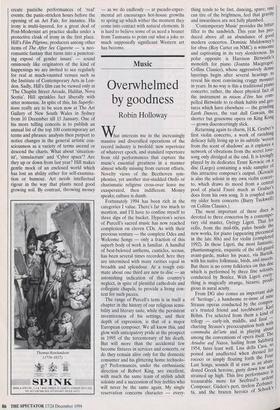Art
Only joking
Giles Auty
The history of artistic spoofs is long and honourable. One has but to think of the fictitious pre-war artist Bruno Hat, brain- child of Brian Howard, Harold Acton and Evelyn Waugh, or the infamous war-time, Australian modern poet Em Malley, the creation of James McCauley and Harold Stewart, who were poets of talent them- selves. I have even dabbled briefly in the genre myself exhibiting 'Relief' — made in half an hour with my left hand — under the pseudonym M.A.F.E. King. The late Dame Still from The After Sex Cigarette by Film Pilgrims Barbara Hepworth did not find my little joke, which was designed to draw attention to the hypocritical standards of the Penwith Society of Artists, of which she was once the leading figure, funny at all, especially since a hanging committee under her control had voted for my handiwork unanimously.
Those who do not spend time in profes- sions whose standards are nebulous — and frequently false — may not understand an irresistible urge to play jokes which may come over those who feel disenfranchised or disenchanted by the business in which they find themselves. During the period when the writings of Ortega y Gasset were cited ceaselessly by art's Left-wing intelli- gensia, I toyed with the idea of quoting occasionally from a lesser-known source: Selig y Tua. Given the humourlessness of the art world, my brazen plan might readily have run and run. However, it was the pal- pable Jose Ortega y Gasset who remarked rightly that the artistic avant-garde is schis- matic in its effect, dividing the world con- veniently into those who understand its arcane mysteries — or claim to, at least and those who do not.
The problem present-day spoofers face is that it has become harder and harder to satirise a subject in which silliness knows no bounds. Short of having a debilitating operation, it would be difficult to write prose daffy enough now for the catalogue introductions to some of our more modish public exhibitions. How can one compete with the ineffable?
To do so demands a kind of holy inno- cence of the sort bred only, perhaps, by prolonged incarceration near the nether end of the world. While I was in Tasmania recently, I met the architectural inventor of a form of low-cost wooden housing which combined beauty with practicality. I also sat in silence for some hours in an unheat- ed bungalow listening to orchestral and operatic CDs which demonstrated a radical breakthrough in systems for producing high fidelity sound. The result, like the appear- ance of the hardware itself, was quite astonishing, leaving me in no doubt that the obscure Australian isle houses one young inventor of genius at least.
Tasmania, which is the size of Ireland but has a population of a mere half million, is also the home of arch artistic hoaxist Peter Hill, founder of The Museum of Contemporary Ideas, which attempts an ironic indictment of the high seriousness and silliness of a lot of the latest, issue- bound art. Hill kindly sent The Spectator his latest press information kit which included the moving image on this page. Under a heading of idees sans frontieres, Hill satirises a host of artistic projects which exist all too truly in present-day, Western cultures. For those accustomed to a diet of art-speak, Hill's tongue-in-cheek projects sound strangely credible. Unsur- prisingly a German art magazine has even taken some at face value.
Hill's fertile imagination inspires him to create pastiche performances of 'real' events: the panic-stricken hours before the opening of an Art Fair, for instance. His irony is multi-layered, for a great deal of Post-Modernist art practice skulks under a protective cloak of irony in the first place. Hill's Film Pilgrims, producers among other items of The After Sex Cigarette — 'a neo- romantic fantasy that turns into a penetrat- ing exposé of gender issues' — sound ominously like originators of the kind of happenings we are invited to see regularly for real at much-vaunted venues such as the Institute of Contemporary Arts in Lon- don. Sadly, Hill's film can be viewed only at `The Chaplin Street Arcade, Halifax, Nova Scotia'. Hill sprinkles fact liberally with utter nonsense. In spite of this, his Superfic- tions really are to be seen now at The Art Gallery of New South Wales in Sydney from 10 December till 15 January. One of his more telling conceits is to publish an annual list of the top 100 contemporary art terms and phrases: analysts then purport to notice changes in the general artistic con- sciousness as a variety of terms ascend or descend the charts. What about 'situation- ist', 'simulacrum' and 'Cyber space'? Are they up or down from last year? Hill makes gentle mock of an enclosed world which has lost an ability either for self-examina- tion or humour. Art needs intellectual rigour in the way that plants need good growing soil. By contrast, throwing money — as we do endlessly — at pseudo-exper- mental art encourages hot-house growths to spring up which wither the moment they come into contact with natural elements. It is hard to believe some of us need a hoaxer from Tasmania to point out what a joke so much supposedly significant Western art has become.











































































































 Previous page
Previous page